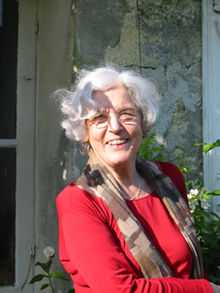Betsy Jolas

Betsy Jolas (born 5 August 1926) is a French composer.
Betsy Jolas, one of the most important forces in contemporary music in France, has influenced a generation of French and American students, as much through her teachings as her compositions.
Biography
Betsy Jolas was the daughter of the translator Maria Jolas and the poet and journalist Eugène Jolas. Her father founded the well known literary magazine "transition", in which James Joyce's "Finnegans Wake" was published under the heading "work in progress". She remembers childhood visits from writers such as Gertrude Stein and Ernest Hemingway.
After graduating from Bennington College (where she became acquainted with 16th century polyphonists including Lassus and Palestrina), Betsy Jolas returned to Paris in 1946 to continue her studies with Darius Milhaud and Olivier Messiaen at the Conservatoire National Supérieur de Musique of Paris.
From 1971 to 1974 Betsy Jolas replaced Olivier Messiaen at the Conservatoire National Supérieur de Musique of Paris and was appointed to the faculty in 1975. She has also taught at Tanglewood, Dartington International Summer School, Yale, Harvard, Mills College (as a holder of the Darius Milhaud Chair), Berkeley, USC and San Diego University. Her works, written for a great variety of combinations, have been widely performed throughout the world.[1]
Style
Betsy Jolas first heard Webern's Fünf Stücke op.10 in the early 1950s, a discovery which struck her like ‘a lightning bolt’, and soon, despite Milhaud's misgivings, she was getting to know the music of avant-garde contemporaries such as Boulez and Stockhausen. With their rigorously contrapuntal conception of musical form and their enthusiasm for unusual timbres and previously unexplored means of sound-production, from voices and instruments alike, these composers provided a source for much that was to become characteristic of Jolas's own emerging style. But there were important differences in her outlook, not least her passion for the voice and its expressive qualities. The confrontation of this essentially lyrical impulse with vocal writing, which embraces the full gamut of avant-garde fragmentation, timbral experimentation, and virtuosity gives her vocal works a special intensity. In her Plupart du temps II (1989) she creates a dialogue of voice, tenor saxophone, and violoncello in which, in her words, “The instruments are made to do what the voice does in daily life, but whereby the instruments are stylized, laughing, weeping, calling out.”
Honors
- Grand prix national de la musique, 1974
- Grand prix de la ville de Paris, 1981
- Grand prix de la SACEM, 1982
- Commandeur des Arts et des Lettres, 1985
- Prix international Maurice Ravel, 1992
- Chevalier de la Légion d'honneur, 1997
- Berlin Prize, 2000
Bibliography
- CC1 (V. Perlis)
- B. Jolas: ‘Il fallait voter sériel même si…’, Preuves, no.178 (1965), 40–42
- M.J. Chauvin: ‘Entretien avec Betsy Jolas’, Courrier musical de France, no.27 (1969), 163–73
- B. Jolas: ‘Voix et musique’, Bulletin de la Société française de philosophie, lxvi/2 (1972) [entire issue]
- I. Krastewa: ‘Betsy Jolas’, SMz, cxiv (1974), 342–9
- D. Henahan: ‘Betsy Jolas Winning Recognition in the USA’, New York Times (30 Aug 1976)
- J.W. LePage: ‘Betsy Jolas’, Women Composers, Conductors, and Musicians of the Twentieth Century, i (Metuchen, NJ, 1981), 103–15
- B. Massin: ‘Betsy Jolas: Roland de Lassus me fascine’, Panorama-musiques, no.41 (1981) [interview]
- ‘Voir la musique’, L'âne, no.10 (1983) [interview]
- J.-P. Derrien, ed.: 20ème siècle: images de la musique française (Paris, 1985), 143–5 [interview]
- J. Briscoe: ‘Betsy Jolas: Plupart du Temps II’, Contemporary Anthology of Music by Women (Bloomington and Indianapolis,1997)
- V. Perlis: ‘Recordings in Review: Betsy Jolas’, Yale Review (1995), 179–85
- B. Jolas: Molto espressivo (Paris, 1999) [collected writings]
- Kennedy, Michael (2006), The Oxford Dictionary of Music, 985 pages, ISBN 0-19-861459-4
- Thurlow, Jeremy (2001). "Jolas, Betsy". The New Grove Dictionary of Music and Musicians, second edition, edited by Stanley Sadie and John Tyrrell. London: Macmillan Publishers.
- J. Briscoe (2011/2012) "Jolas, Betsy". Grove Dictionary of American Music, 2nd ed. 2012. Oxford Music Online.
References
External links
- Excerpts from sound archives of Jolas's works.
- Betsy Jolas interview by Bruce Duffie, July 17, 1991
- A biography on IRCAM's website (French)
|